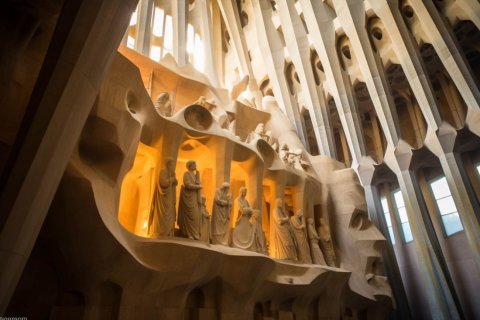Discover the awe-inspiring Sagrada Familia with a skip-the-line guided tour that allows you to explore its intricate interior and diverse architectural styles. Uncover the ever-changing history of this masterpiece by Antoni Gaudí, immersing yourself in its wonder.
Begin your journey at the Nacimiento façade, delving into the Basilic's insides and Pasión façade. Explore the Sagrada Familia's school and post-tour, consider a visit to the Museum of the temple's construction.
Your experience encompasses admission tickets, skip-the-line privileges, an official local guide, and an audio system for a comprehensive exploration. Revel in Gaudí's brilliance, marvel at the finest Catalan modern architecture, and absorb the stories and legends entwined with this remarkable edifice.
Make your visit seamless and comfortable, keeping in mind essentials such as comfortable shoes, clothing, and water. Ensure you adhere to guidelines like no pets, smoking, or large bags inside. Special wheelchair access is available.
Experience the Sagrada Familia in French, English, or Spanish with available tours. Embrace the opportunity to witness this extraordinary creation, immersing yourself in its history, architecture, and artistry.
Highlights:
- Enjoy a guided tour of the Sagrada Familia
- Marvel at the finest Catalan modern architecture
- Discover all the stories and legends about this temple
- Hear the history of the ever-changing art
Includes:
- Admission ticket
- Skip-the-line tour
- Official local guide
- Immediate confirmation
- Audio system
Meeting Point:
Meeting point may vary depending on the option booked. Choose from tours in French, English, or Spanish.
Important Information:
- What to bring: Comfortable shoes, Water, Comfortable clothes
- Not allowed: Pets, Smoking, Luggage or large bags
- Special access for wheelchairs
Customer Reviews:
Overall rating: 4.8/5 based on 923 reviews
Review summary:
- Guide: 4.8/5
- Value for money: 4.5/5
- Service: 4.8/5
- Organization: 4.7/5
People often mention: Tour Guide, Church, Sagrada Familia, Building, Questions, History, Knowledge, Detail, Architecture, Group, People, Cathedral
History and Symbolism: Wonders of Architecture
Architecture is a timeless reflection of a society's values, beliefs, and culture. It encompasses not only the physical structures we see and experience but also the symbolic meanings and historical significance that each edifice holds. The fusion of history and symbolism in architecture creates wonders that continue to captivate and inspire us.
Throughout history, architecture has played a pivotal role in shaping civilizations and leaving a lasting mark on the world. From the grand pyramids of Egypt to the intricate cathedrals of Europe, each structure tells a unique story of the people, their way of life, and their aspirations.
The historical aspect of architecture is a journey through time, offering glimpses into different periods and their architectural styles. Ancient civilizations like the Greeks and Romans showcased their prowess through imposing structures like the Parthenon and the Colosseum. The medieval era brought forth stunning castles and fortresses, demonstrating a need for security and fortification.
As time progressed, the Renaissance period ushered in a revival of classical aesthetics and a focus on humanism. The architecture of this time, seen in the works of Michelangelo and Leonardo da Vinci, celebrated the beauty of the human form and intellect, giving rise to architectural marvels like the St. Peter's Basilica in Vatican City.
Each architectural style carries its own symbolism, deeply rooted in the culture and beliefs of the time. For instance, Gothic architecture with its pointed arches and ribbed vaults symbolizes an aspiration towards the divine, aiming to reach the heavens through the soaring spires and intricate designs. On the other hand, modernist architecture emphasizes functionality and minimalism, reflecting a break from traditional ornamentation and a focus on efficiency.
Symbolism in architecture extends beyond aesthetics, encompassing spiritual, cultural, and social representations. Many religious structures are laden with symbolic elements, conveying the beliefs and stories of the faith they represent. Take the Sagrada Familia in Barcelona, an ongoing masterpiece by Antoni Gaudí, where every detail holds symbolic meaning, depicting biblical narratives and the glory of God.
Furthermore, architectural wonders often become iconic landmarks, representing cities and nations globally. The Eiffel Tower in Paris, the Taj Mahal in India, and the Sydney Opera House in Australia are not just architectural feats but symbols of the respective cultures and destinations they belong to. They attract millions of visitors, leaving them in awe of human creativity and ingenuity.
Frequently Asked Questions (FAQs)
Q: How does history influence architectural styles?
History profoundly influences architectural styles by reflecting the social, cultural, and technological advancements of a particular period. Different eras have distinct architectural features influenced by the prevailing beliefs, needs, and available materials.
Q: What role does symbolism play in architecture?
Symbolism in architecture adds depth and meaning to the built environment. It conveys cultural, spiritual, and social messages, allowing individuals to connect with the structure on a profound level beyond its physical form.
Q: What are some iconic architectural landmarks?
Iconic architectural landmarks, such as the Eiffel Tower, Taj Mahal, and Sydney Opera House, are globally recognized structures that represent the culture, history, and identity of the places they are located in. They are often visited by tourists and admired for their architectural beauty and significance.



